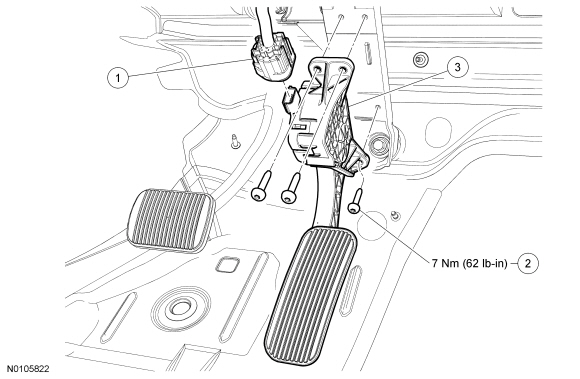SPECIFICATIONS
Torque Specifications

DESCRIPTION AND OPERATION
Acceleration Control
The acceleration controls consist of the accelerator pedal and sensor assembly.
The engine management system electronically operates the throttle of the engine in response to throttle pedal movements initiated by the driver. In the event of a system failure, the engine management system provides a "limp home" mode which allows the car to be driven with limited performance.
DIAGNOSIS AND TESTING
Acceleration Control
Refer to the Powertrain Control/Emissions Diagnosis (PC/ED) manual.
REMOVAL AND INSTALLATION
Accelerator Pedal


Removal and Installation
- Disconnect the accelerator pedal sensor electrical connector.
- Remove the 3 accelerator pedal and sensor bolts.
- To install, tighten to 7 Nm (62 lb-in).
- Remove the accelerator pedal and sensor assembly.
- To install, reverse the removal procedure.
 Fuel Tank and Lines
Fuel Tank and Lines
SPECIFICATIONS
General Specifications
Torque Specifications
DESCRIPTION AND OPERATION
Fuel Tank and Lines
2.0L Gasoline Turbocharged Direct Injection (GTDI)
Fuel Tank and Lines
The fuel tank and l ...
 Electrical
Electrical
...
Other materials:
Child Safety
• You are required by law to properly use safety seats for infants and
toddlers in the United States and Canada.
• Many states and provinces require that small children use approved
booster seats until they reach age eight, a height of 4 feet 9 inches
(1.45 meters) tall, or 80 pounds (36 ...
General information
Have your vehicle serviced regularly to help maintain its roadworthiness
and resale value. There is a large network of Ford authorized dealers who
are there to help you with their professional servicing expertise. We believe
that their specially trained technicians are best qualified to service y ...
Exterior Trim and Ornamentation
SPECIFICATIONS
Torque Specifications
REMOVAL AND INSTALLATION
Applique - Luggage Compartment Lid
Removal and Installation
NOTE: Removal steps in this procedure may contain installation
details.
To install, tighten to 5 Nm (44 lb-in).
If equipped.
To ...
